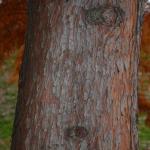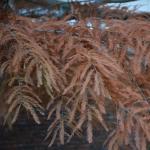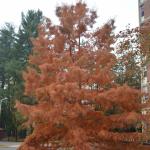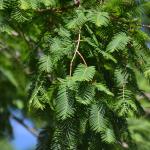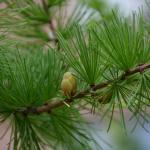A monthly e-newsletter from UMass Extension for landscapers, arborists, and other Green Industry professionals, including monthly tips for home gardeners.
To read individual sections of the message, click on the section headings below to expand the content.
To print this issue, either press CTRL/CMD + P or right click on the page and choose Print from the pop-up menu.
Invasive Plant Certification Program, Ending in 2023
While turf and landscape professionals might be very proficient in the development of a weed management program for turf and/or landscape, invasive plant management often reveals many new and unique challenges to these professionals. This 4-day program is intended to help participants meet these challenges when attempting to develop an invasive plant management program as part of their business. A certificate in Invasive Plant Management may be obtained by attending all four sessions and obtaining a passing grade on each. 2023 will be the final year we offer this certificate program. Those who have taken some of the classes in this series in the past and still wish to earn the certificate of completion are advised to finish up any remaining classes in 2023.
The four sessions are:
- Principles and Fundamentals of Weed Science (A1)
- State Regulations Pertaining to Invasive Plant Management (A2)
- The Invasive Plant Issue and Invasive Plant Identification (A3)
- Developing an Invasive Plant Management Program (B)
For more details, go to https://ag.umass.edu/landscape/education/invasive-plant-certification-program
Partial reimbursement for the cost of classes in the Invasive Plant Certification Program is available in 2023 for eligible Massachusetts employers thru the Workforce Training Fund Program's Express Program: https://commcorp.org/subprogram/wtfp-express-program.
Invasive Insect Webinar Series
On January 25, February 8 and 22, 2023 UMass Extension’s Landscape, Nursery, and Urban Forestry Program and UMass Extension’s Fruit Program presents a series of FREE webinars focusing on the impact, monitoring, and management of invasive insects in Massachusetts and the nation! Note: Much of the material presented in these webinars is specific to Massachusetts and New England.
Topics include:
- Forest Pest Risk is Heating Up with Climate Change
- Spotted Lanternfly Updates for Massachusetts from MDAR
- Spotted Lanternfly Management in the Landscape
- Entomopathogens of Spotted Lanternfly, Biopesticides, & Scouting Egg Masses in Vineyards
- Beech Leaf Disease: and the Newly Described Nematode That Causes It
- Invasive Forest Insects in Massachusetts
For the entire 2023 Invasive Insect Webinars schedule and registration links, as well as to view recordings of past invasive insect topics, go to https://ag.umass.edu/landscape/education-events/invasive-insect-webinars.
Featured Plant
Is That an “Evergreen” With Fall Color?
Although most conifers are evergreen, there are five genera of deciduous conifers: Taxodium distichum (bald cypress), Metasequoia glyptostroboides (dawn redwood), Larix spp. (larch), Pseudolarix amabilis (golden larch), and Glytostrobus pensilis (Chinese swamp cypress). Deciduous conifer foliage provides a soft texture to the landscape and the fall foliage can be golden, orange, or cinnamon brown.
Taxodium distichum is native to coastal areas and swamps of the southeastern United States. Trunks are buttressed at the base. Plants are adapted to growing directly in the water or in somewhat drier areas. When growing in water, plants have “knees” which are knobby root growths that rise above the water surface. Foliage is soft and feathery. The light green summer foliage turns to a warm orange, cinnamon-brown color in the fall. Cones are rounded, purplish green when young, maturing to brown. Needles are two-ranked, alternate, and pointed at the tips. These long-lived trees are pyramidal in shape growing 50-70’ tall (sometimes larger). Best used as a large, specimen tree for parks or lawns, or along ponds.
Metasequoia glyptostroboides is closely related to bald cypress (Taxodium) and redwood (Sequoia). It is known from fossil records to have existed as many as 50,000,000 years ago but was only realized to be growing in the wild in 1941 when it was discovered in China. Dawn redwood is another large growing, pyramidal tree reaching up to 100’ tall. Similar to bald cypress, the trunk widens at the base and can have fluting. Bark is often deeply fissured. Foliage is also similar to bald cypress; however, Metasequoia needles are opposite and rounded at the tip. The foliage is deep green in summer turning red-bronze in fall. Trees have two types of cones: light brown, ¾” oval female cones and ½” globose male cones. Trees do best with consistent moisture but don’t thrive in wet conditions like bald cypress. Another good specimen for large areas. The genus names comes from the relationship to Sequoia and the specific epithet means resembling the genus Glyptostrobus, which the species was originally confused with.
Larix species are native to the northern parts of North America, Europe, and Asia. Three species are native to the United States with Larix lyallii (Alpine larch) and Larix occidentalis (Western larch) being native to the mountains of the western United States. Larix laricina, commonly known as eastern larch or tamarack, is native to areas of Alaska, Canada, and the northeastern US from Minnesota to Maine and south to parts of Maryland. Other Larix species found in the trade include, Larix decidua (European larch), Larix kaempferi (Japanese larch), and Larix gmelinii (Dahurian larch).
Eastern larch (Larix laricina) has an open pyramidal growth habit reaching 40-60’ tall. Needles grow in clusters arising from short spurs along branches. Needles are green during the growing season turning golden brown in fall. Cones are small, rounded, and purple when young, maturing to brown. Bark on mature tress is scaly, reddish brown. Larch is native to boggy and wet areas so does not tolerate dry conditions. Trees do best when summers are cool and winters are cold.
European larch (Larix decidua) also has a pyramidal shape with horizontal branches and drooping branchlets, growing 60-100’ tall. Like other larch, needles are in clusters arising from spurs. The green summer foliage turns golden yellow in fall. Cones are reddish brown and covered with brown hairs. Similar to eastern larch, it does not tolerate dry soils and prefers cooler climates.
Pseudolarix amabilis’ genus name come from its resemblance to Larix. Golden larch is native to southeastern China. It is slow growing to 30-60’ tall (getting taller in the wild), broadly conical with horizontal branching and dropping branchlets. Needles are light green during the growing season turning golden yellow in the fall. Similar to larch, needles are in clusters. The ovate cones are greenish purple in summer maturing to golden brown, shattering when they reach maturity to release seeds. Best planted in areas protected from strong winds.
Glytostrobus pensilis is native to southern China, Laos, and Vietnam; it is only hardy to zone 8 and therefore not suited for northern climates.
A relative of the conifers, Ginkgo biloba, is also quite spectacular this time of the year. Ginkgo are often “grouped” together with conifers as they are gymnosperms. They technically have their own division in the phylogenetic tree. Gingko biloba is the sole representative of the class, order, family, genus, and species! The unique, fan-shaped leaves of the gingko stand out in the plant world and speak of the uniqueness of gingko. Fall color is vibrant yellow. After a hard frost, most of the leaves will fall, creating a yellow carpet on the ground. This is another trait that makes gingko unique, since other trees develop leaf scars over the course of several weeks in the fall resulting in gradual leaf fall. The gingko however forms leaf scars all at the same time, resulting in the abrupt fall of nearly all of leaves.
Mandy Bayer, Extension Assistant Professor of Landscape Horticulture
Trouble Maker of the Month
Arborvitae Needle Blight
In 2022, the UMass Plant Diagnostic Lab received numerous samples of arborvitae (Thuja spp.) suffering from needle blight caused by the fungal pathogens Pestalotiopsis and Phyllosticta. While the lab receives a significant number of arborvitae samples every year, the volume in 2022 was considerably higher than average. The samples encompassed several species and cultivars, most of which included: T. occidentalis ‘Nigra’ (Dark American), T. occidentalis ‘Smargd’ (Emerald Green), T. plicata (Western red-cedar) and T. plicata × standishii (Green Giant). Increasingly, the lab is receiving Green Giant samples, which may be reflective of their emerging popularity. Green Giant arborvitaes exhibit very rapid growth, creating a dense privacy screen more quickly after transplanting. However, Green Giants ultimately attain much greater heights and widths than Dark American and Emerald Green and can be more susceptible to winter injury in some cases. While some believe Green Giant offers enhanced resistance to deer browsing compared to Emerald Green and Dark American, when deer populations are high all arborvitae are susceptible.
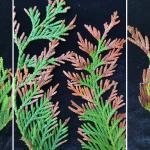 Symptoms of arborvitae needle blight have ranged from scattered branch dieback to severe browning in the canopies and outright death in some situations. In cases where trees have died, there are often multiple stresses involved that span beyond needle blight alone. There are so many arborvitaes in the landscape that some invariably suffer from poor planting techniques, excessive shade, dry and compacted soils, limited rooting zones, and other site-related stresses. It’s not entirely clear why established arborvitaes developed damaging outbreaks of needle blight over the past year but it could be related to recent weather trends. While mature arborvitaes are resistant to heat and drought, Thuja species generally require more soil moisture compared to other landscape conifers such as pine (Pinus) and juniper/red-cedar (Juniperus). Short-term droughts and extreme heat during the growing season in 2020 and 2022 could have contributed to needle blight outbreaks. When conifers are drought-stressed, they are more susceptible to attack by foliar pathogens. Conversely, the excessive rainfall in 2021, especially during the months of September and October, could also have fueled the latest outbreak. The fungal pathogens responsible can sporulate and spread anytime moisture is plentiful and temperatures are mild. Free moisture on the needle surface allows these fungi to sporulate and readily spread to nearby needles and trees.
Symptoms of arborvitae needle blight have ranged from scattered branch dieback to severe browning in the canopies and outright death in some situations. In cases where trees have died, there are often multiple stresses involved that span beyond needle blight alone. There are so many arborvitaes in the landscape that some invariably suffer from poor planting techniques, excessive shade, dry and compacted soils, limited rooting zones, and other site-related stresses. It’s not entirely clear why established arborvitaes developed damaging outbreaks of needle blight over the past year but it could be related to recent weather trends. While mature arborvitaes are resistant to heat and drought, Thuja species generally require more soil moisture compared to other landscape conifers such as pine (Pinus) and juniper/red-cedar (Juniperus). Short-term droughts and extreme heat during the growing season in 2020 and 2022 could have contributed to needle blight outbreaks. When conifers are drought-stressed, they are more susceptible to attack by foliar pathogens. Conversely, the excessive rainfall in 2021, especially during the months of September and October, could also have fueled the latest outbreak. The fungal pathogens responsible can sporulate and spread anytime moisture is plentiful and temperatures are mild. Free moisture on the needle surface allows these fungi to sporulate and readily spread to nearby needles and trees.
To read more about arborvitae needle blight, including potential management strategies and to see photos of the symptoms and signs, see our UMass Extension fact sheet at https://ag.umass.edu/landscape/fact-sheets/arborvitae-needle-blight
Nicholas J. Brazee, UMass Extension Plant Pathologist
Q&A
Q. We use quinclorac, Drive XLR8TM, for weed control on the turf properties that we manage. The label calls for a surfactant, either MSO (methylated seed oil) or, if MSO is not available, a COC (crop oil concentrate) can be used. Is a surfactant required for a quinclorac application done during the establishment of turf from seed to manage crabgrass and other annual grasses?
A. Surfactants are not needed when quinclorac or any other preemergence herbicide is used. If the product label calls for the addition of a surfactant, then one should be added. Without the surfactant, the product will very likely not perform or a reduction in efficacy will result. The addition of a surfactant to a product that doesn’t require one can result in injury to cool-season turfgrasses as a result of a loss of herbicide selectivity.
Q. In the last couple of years we have used Garlon 3ATM or Garlon 4TM to control Japanese knotweed with mixed results. Why does it only work sometimes?
A. “Mixed results” are typical with triclopyr on Japanese knotweed and, if control is achieved, it usually requires multiple applications. Better herbicide choices for Japanese knotweed control are glyphosate (Roundup ProTM, Roundup Custom for Terrestrial and Aquatic UseTM, RodeoTM, AquaNeatTM) and aminopyralid (MilestoneTM). Review product labels for application rate and timing.
Q. My company started using LontrelTM for weed control on a few of the lawns we manage. Control of some weeds has been very good. However, we have had zero succuss controlling wild strawberry. Why weren't we able to control wild strawberry and what products should we consider using?
A. First and foremost, LontrelTM is a single herbicide product that contains clopyralid and there is a federal residential turf restriction on products that contain clopyralid. In other words, clopyralid products can be used on all types of turf other than residential lawns. Secondly, wild strawberry is in the rose family (Rosaceae) along with other notable plants including apples, pears, quinces, medlars, loquats, almonds, peaches, apricots, plums, cherries, strawberries, blackberries, raspberries, sloes, and roses. Members of the rose family are very tolerant to clopyralid. The best herbicides for wild strawberry management include triclopyr and dicamba applied in very late summer and early fall.
Q. Two years ago, I took and completed section A1 of the Invasive Plant Certification Program. I wish to complete that remaining sections and earn by certificate of completion in invasive plant management. Will this program be offered in 2023?
A. Yes, but the Invasive Plant Certification Program will be offered for the last time in 2023. Dates for the program can be found on the Landscape Nursery and Urban Forestry event page https://ag.umass.edu/landscape/upcoming-events. Note that since 2023 will be the last year that this program is offered, individuals who are in various stages of completion and would like to finish the program should plan on doing it in 2023.
Randy Prostak, UMass Extension Weed Specialist
Garden Clippings Tips of the Month
November is the month to . . . .
-
Remove fallen leaves from the lawn. Accumulating leaves on the lawn prevents sunlight from reaching the turf grasses during this important time of lawn growth, greatly reducing photosynthesis, slowing the growth of turf grasses, and also affecting their acclimatization to dormancy through the winter. A thick layer of leaves can also smother the grass. Rake up leaves and put them on the compost pile, or grind them up with your mower. For a discussion of the additional pros and cons of leaving leaves on the lawn, see Leave the Leaves: Save the Moths, Save Your Back, Save the TICKS? in the October issue of Hort Notes.
-
Apply lime to lawns and/or gardens. If a soil test recommends raising the soil pH, apply lime as recommended by the soil test. Applying lime in the fall gives the lime adequate time to react with the soil to raise the soil pH. It can take as long as 4-6 months for the lime to raise the soil pH, so a fall application will help prepare the garden for the next year’s growing season. See http://umass.edu/soiltest for info on how to submit a sample to the UMass Soil and Plant Nutrient Testing Laboratory.
-
Remove spent plants from garden. Once harvest is complete, vegetable plants and spent annuals should be removed to reduce the risk of disease and insect pests overwintering and carrying over to the next season. Top growth of perennial plants that die to the ground can also be removed except for disease free ornamental grasses and plants such as Echinacea (coneflower), Eutrochium (Joe-Pye weed), and Rudbeckia (black-eyed Susan) that can provide birds with seeds and vertical accent during the winter. Alternatively, leaving perennials untrimmed until the spring provides places for beneficial insects and some pollinators to safely overwinter.
-
Mulch berries and perennials. Mulch perennials and berries after the first hard freeze to help protect them from frost heaving caused by the freezing and thawing of the soil. Organic mulches help to moderate temperature fluctuations, protecting plants from frost heaving. Fall mulch application can also help smother winter annual weeds, decrease runoff and increase water retention for the following summer. Mulches also protect the soil from compaction by rain and foot traffic.
-
Service the lawn mower. Take your lawn mower to your local small engine service shop or service it yourself. Empty any gas before servicing, as stale gas is a major problem with lawn mowers and other small engine equipment. When a lawn mower sits in storage for several months, water condenses in the gas tank and gets into the gas. To empty the gas, turn on the engine and let it run for about 30 seconds to one minute, then shut it off and siphon the gas. Restart the engine and run it until it stops. After emptying the gas, remember to change the oil, the spark plugs, and air filter(s). Always follow the directions in the owner’s manual.
-
Rake up leaves and remove mummified fruit. Leaves and mummified fruit from fruit trees that were diseased should be raked up, removed, and destroyed to reduce the amount of disease pathogens carried over to the next season. Fungi that cause leaf and fruit spots can overwinter in infected debris in soil or under the plants. They stay in a dormant state until the following spring when rains and warmer weather induce the production of spores which are disseminated by wind and rain to infect the plants during the growing season. Removal of infected plant material helps to reduce the amount of disease pathogens present in the area, thus reducing the amount of potential disease for the next season. Therefore, leaves and mummified fruits should not be thrown into the compost pile.
-
Keep evergreen shrubs well-watered. Deep, late fall watering ensures that the roots of shrubs take up enough water to keep them hydrated during the winter. Broadleaf evergreens such as rhododendrons, holly, boxwood and mountain laurel can lose considerable amounts of moisture through their leaves during the winter months, mainly due to strong winds and sun. Winter sun and wind can cause excessive foliage water loss while the roots are in frozen soil and unable to replace lost water. This results in desiccation and browning of the plant tissue. To prevent desiccation injury, deeply water broadleaf evergreens in late fall if the soil is dry and continue watering on a regular basis until the ground freezes.
-
Protect tender evergreens shrubs from winter damage. Broadleaf evergreens are susceptible to dry, cold winds which can cause desiccation of leaves. If exposed to wind, the leaves get desiccated and appear brown and dead in late winter and spring. Protect plants from drying winter winds by erecting wind breaks made of burlap attached to frames on the side facing the prevailing winds. Stakes can be placed about 12-18 inches away from the plant to support the burlap barrier.
-
Reduce watering and fertilizer application to houseplants. During the months of cold temperatures and shorter days, the growth of most houseplants slows down. During this period, new growth is minimal. Reduce fertilizer application and watering house plants until late winter or early spring when new growth resumes.
Geoffrey Njue, UMass Extension Sustainable Landscapes Specialist
The Hidden Helpers: Beneficial Insects in Urban Landscapes
Urban landscapes are unique ecosystems, which are highly complex, often artificial communities with diverse mosaics of native and exotic, annual and perennial plant species. Each landscape is uniquely managed depending on ownership. These diverse plant communities are hosts for diverse communities of insect herbivores, which at times can cause significant damage and require management intervention. But insect pest management in such systems is very challenging, requiring flexibility, knowledge of many insect pest species and regular monitoring.
Luckily, only about ~5% of all insects are pests. Many insect species play an important part in the balanced ecosystem and are beneficial. Beneficial insects can be pollinators or decomposers, contributing to nutrient cycling in ecosystem. Some beneficial insects and arthropods are an important part of pest management, keeping the insect herbivore populations at bay and preventing pest outbreaks. It has been estimated that the value of the pest control services provided by several groups of beneficial insects in agricultural systems is about $4.6 billion annually[1]. The diversity of the plant communities and availability of flowering plants favors abundance and diversity of natural enemies and increases the level of the predation and parasitism of pest insects[2, 3]. Considering the complexities of urban landscapes, the contribution of the natural enemies might be even more significant.
The complex of natural enemies in landscapes usually includes predators and parasitoids. Adults, larvae or both stages of predatory insects feed on the pest insects and usually consume multiple organisms for the duration of their lifespans. Generalists can feed on a wide range of insects; specialists only feed on one species or very narrow group of insects. Urban landscapes specifically favor the generalists because of ecosystem patchiness, fragmentation and complexity[4]. Some natural enemy species are very vulnerable to urbanization and therefore are represented less in such systems, for instance specialist predators and parasitoids[5]. Others, such as generalist predators, are resilient to urbanization and are abundant in such systems. For instance, spiders are the most dominant predators in many systems, they make 69 % of all generalist predators in urban landscapes[4]. Fortunately, urban landscapes are more flexible for modification, such as by adding flowering species; therefore the negative effect of urbanization can be mediated by creating a food and refuge areas for natural enemies.
Some of the most common groups of predators are presented in Figure 1 and Table 1 (below).
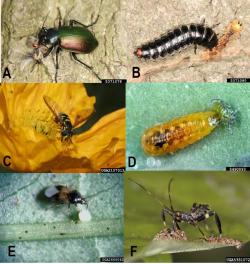 Among the most common predators are ground beetles (family Carabidaes). This family includes many beneficial species, some of which help to control weeds by consuming their seeds, while others are generalist predators of insects and arthropods. Several species were introduced into Massachusetts as a part of classical biological control to combat another invasive species. For example, relatively large, bright colored ground beetles (Calosoma sycophanta) were introduced in New England in 1905 to combat spongy moth (Lymantria dispar) infestations. Both adults and larvae of this species (Figure 1, A and B respectively) climb trees and feed on spongy moth caterpillars and pupae[6]. Multicolored lady beetle (Harmonia axyridis) was also introduced to the US to combat crop pests; now it is commonly found throughout the country. Larvae and adults feed on aphids, mites, thrips, scales, and Lepidoptera eggs. Many native insect species (beetles, flies, ants, wasps) are effective predators of pest insects. For instance, larvae of several species of hover or syrphid flies (Figure 1, C adult, D larva) feed on aphids and other soft bodied insects, significantly reducing their populations. Several species of insects with piercing-sucking mouthparts (true bugs) are also important predators of soft bodied insects. Orious spp., or minute pirate bug, is a voracious predator in spite on of its small size (Figure 1, E).
Among the most common predators are ground beetles (family Carabidaes). This family includes many beneficial species, some of which help to control weeds by consuming their seeds, while others are generalist predators of insects and arthropods. Several species were introduced into Massachusetts as a part of classical biological control to combat another invasive species. For example, relatively large, bright colored ground beetles (Calosoma sycophanta) were introduced in New England in 1905 to combat spongy moth (Lymantria dispar) infestations. Both adults and larvae of this species (Figure 1, A and B respectively) climb trees and feed on spongy moth caterpillars and pupae[6]. Multicolored lady beetle (Harmonia axyridis) was also introduced to the US to combat crop pests; now it is commonly found throughout the country. Larvae and adults feed on aphids, mites, thrips, scales, and Lepidoptera eggs. Many native insect species (beetles, flies, ants, wasps) are effective predators of pest insects. For instance, larvae of several species of hover or syrphid flies (Figure 1, C adult, D larva) feed on aphids and other soft bodied insects, significantly reducing their populations. Several species of insects with piercing-sucking mouthparts (true bugs) are also important predators of soft bodied insects. Orious spp., or minute pirate bug, is a voracious predator in spite on of its small size (Figure 1, E).
While native or exotic predators are usually well recognized by practitioners and the general public, parasitoids are usually less noticeable. Parasitoids usually are flies or wasps (Diptera and Hymenoptera) larvae which feed on the host inside (endoparasitoid) or outside (ectoparasitoid) of the insect body, eventually killing it. Many parasitoid species, especially wasps, are hard to identify because of their size and difficulties in collecting and monitoring them, especially considering that most of their development occurs inside of the host insects. It is also a very diverse group; there are about 50 different families of parasitoids and the majority of them are very small and rarely noticed. In spite of that, it is believed that parasitoids are more successful in reducing the pest population than the generalist predators[5]. It is important to recognize their presence and service in landscape communities.
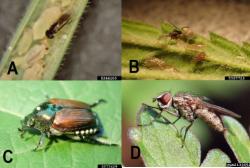 One of the most common and best known family of wasp parasitoids is Aphelinidae (Figure 2A), which are effective parasitoids of aphids, scales, mealy bugs, and white flies. Braconidae (braconid wasps) is another diverse family of the predominately small endoparasitoids (Figure 2B). Their usual hosts are aphids, caterpillars, beetle larvae, leaf miners, flies, true bugs, and sawflies.
One of the most common and best known family of wasp parasitoids is Aphelinidae (Figure 2A), which are effective parasitoids of aphids, scales, mealy bugs, and white flies. Braconidae (braconid wasps) is another diverse family of the predominately small endoparasitoids (Figure 2B). Their usual hosts are aphids, caterpillars, beetle larvae, leaf miners, flies, true bugs, and sawflies.
Among the flies, tachinid flies (Family Tachinidae) are the most known and common endoparasitoids. Adult tachinid flies look similar to houseflies (Figure 2D). Females lay eggs on the host; larvae later hatch and make their way in the host, feeding inside and eventually killing it (Figure 2, C). For example, Winsome fly (Tachinidae), is a parasitoid of Japanese beetle adults which was introduced to the US to control a Japanese beetle invasion in the early 1900s. These flies lay their eggs on the pronotum of the female Japanese beetle (Figure 2 C). When the egg hatches, the larva burrows inside the beetle; parasitized female beetles then burrow into the soil and usually die within 1-3 days. According to our recent observations in western Massachusetts, the level of parasitism of Japanese beetles by Winsome flies is approximately 15%. This species is also established in several other states.
Often unnoticed, the contribution of natural enemies, both predators and parasitoids, to pest control is invaluable. In many cases, pressure from natural enemies keeps the insect herbivore population under the damage threshold and prevents pest outbreaks. Therefore, naturally occurring natural enemies are an important part of an IPM program. In fact, naturally occurring predators and parasitoids are responsible for about 50-90% of biological control of several agricultural pests[7]. However, some insect pest management strategies are not compatible with this biocontrol or affect natural enemies negatively. For instance, use of broad spectrum, non-selective insecticides (organophosphates, pyrethroids) can have significant non-target effect. Several studies suggest that prolonged use of broad-spectrum chemicals can lead to the disturbance or elimination of the natural enemies’ complex, resulting in unexpected secondary pest outbreaks[7]. Therefore, to protect natural enemies, it is recommended to use selective or biorational insecticides which have little or no effect on natural enemies. Insecticides that are not persistent and/or have to be ingested by pests (do not act on contact) had lesser impact on the natural enemy complex. Some of these include horticultural oils, insecticidal soaps, neem oil, azadiractin, and spinosad. Several biorational insecticides are also very selective in their activity, affecting only very specific groups of pests, for example Bacillus thuringiensis (Bt), microbial insecticides (fungi, bacterials), or nematodes.
Another approach to improve the abundance and efficiency of natural enemies is to provide a food bank and habitats for these. Several studies have demonstrated that providing patches with flowering plants improve abundance and diversity of natural enemies, especially parasitoids. As a result, the levels of parasitism and predation increases, leading to reduced herbivore pest densities and damage[2]. Flowering plants are a rich source of nectar and pollen that are attractive for many beneficial insects such as parasitoid wasps, flies, lady beetles, and green lacewings. The most attractive to parasitoids are the flowering plant families Umbelliferae, (carrot family: parsnip, fennel, dill, cilantro, Queen Anne’s lace), Compositae (aster family: cosmos, golden rode, yarrow, sunflower), Brassicaceae (mustard family: alyssum, mustards), Fabaceae (been family: alfa alfa, sweet clover), and some others. It is important to provide a food source for beneficial insects throughout the season continuously by selecting plant species that flower sequentially.
Table 1. Common naturally occurring predatory insect and arthropods of landscapes.
| Order | Common name | Scientific name | Type | Prey |
| Coleoptera (beetles) |
Lady beetles | Family Coccinelidae | generalist | aphids, caterpillars, moth eggs, scales, mites |
| Ground and tiger beetles | Family Carabidae | generalist | aphids, caterpillars, other beetle larvae, fly larvae, mites, springtails, slugs | |
| Rove beetles | Family Staphylinidae | generalist | many species, especially small fly larvae | |
| Hymenoptera | Ants | Family Formicidae | generalist | wide range |
| Diptera (flies) |
Syrphids/hover flies | Family Syrphidae | specialist | larvae prey on aphids, adults feed on nectar |
| Robber flies | Family Asilidae | generalist | wide range | |
| Hemiptera (true bugs) |
Minute pirate bug | Orius spp. | generalist | mites, thrips, aphids and other small insects |
| Big-eyed bug | Geocoris spp. | generalist | wide range of mites and small insects | |
| Spined soldier bug | Podisus maculiventris | generalist | wide variety of arthropods, especially caterpillars and beetle larvae | |
| Assassin bugs and ambush bugs | Family Reduviidae | generalist | wide range | |
| Neuroptera | Green lacewings | Family Chrysopidae | generalist | mites and soft-bodied insects including aphids, caterpillars, lace bugs, leafhoppers, mealybugs, psyllids, scales, and thrips |
| Brown lacewing | Family Hemerobiidae | generalist | primarily aphids but also mealybugs, white flies, spider mites, scales, and on insect eggs | |
| Arthropods, Arachnida |
Spiders | Order Araneae | generalist | wide range |
| Predatory mites | Order Acari, Phytoseiulus, Galendromus and Neoseiulus spp. | generalist | spider mites, other plant-feeding mites, eggs and immature stages of thrips, whiteflies, scales species feed on pollen, honeydew, fungi, and leaf sap |
References
1. Losey J.E., Vaughan M. 2006. The economic value of ecological services provided by Insects, BioScience, 56: 311–323
2. Ellis J.A., Walter A.D., Tooker J.F., Ginzel M.D., Reagel P.F., Lacey E.S., Bennett A.B., Grossman E.M., Hanks L.M. 2005. Conservation biological control in urban landscapes: Manipulating parasitoids of bagworm (Lepidoptera: Psychidae) with flowering forbs, Biological Control, 34: 99-107
3. Tooker J.F., Hanks L.M. 2000. Influence of plant community structure on natural enemies of pine needle scale (Homoptera: Diaspididae) in urban landscapes, Environ Entomol, 29: 1305–1311
4. Dix M.E., Baxendale F.P. 1997. Insect pests and Arthropod predators associated with tree-turf landscapes J. Entomol Sci, 32: 257-270.
5. Burkman C.E., Gardiner M.M.2014.Urban greenspace composition and landscape context influence natural enemy community composition and function, Biological Control, 75: 58-67
6. Schaefer P.W., Fuester R.W., Taylor P.B., Barth S.E., Simons E.E., Blumenthal E.M., Handley E., Finn T.B., Elliott E.W. 1999. Current distribution and historical range expansion of Calosoma sycophanta (L.) (Coleoptera: Carabidae) in North America. J. Entomol Sci 34: 339-362.
7. Pimentel D. 2005. Environmental and economic costs of the application of pesticides primarily in the United States. Environ Dev Sustain: 229–252
Olga Kostromytska, Extension Assistant Professor of Turf Entomology, UMass Amherst
Upcoming Events
For details and registration options for these upcoming events, go to the UMass Extension Landscape, Nursery, and Urban Forestry Program Upcoming Events Page.
- 1/25/23 - Invasive Insect Webinar Series: Day 1
- 2/8/23 - Invasive Insect Webinar Series: Day 2
- 2/22/23 - Invasive Insect Webinar Series: Day 3
- 3/16/23 - State Regulations Pertaining to Invasive Plant Management (A2 of the Invasive Plant Certification Program)
- 3/23/23 - Principles and Fundamentals of Weed Science (A1 of the Invasive Plant Certification Program)
- 4/6/23 - The Invasive Plant Issue and Invasive Plant Identification (A3 of the Invasive Plant Certification Program)
- 4/13/23 - Developing an Invasive Plant Management Program (B of the Invasive Plant Certification Program)
Pesticide Exam Preparation and Recertification Courses
These workshops are currently being offered online. Contact Natalia Clifton at nclifton@umass.edu or go to https://www.umass.edu/pested for more info.
InsectXaminer!
Episodes so far featuring gypsy moth, lily leaf beetle, euonymus caterpillar, imported willow leaf beetle, and spotted lanternfly can be found at: https://ag.umass.edu/landscape/education-events/insectxaminer
TickTalk with TickReport Webinars
To view recordings of past webinars in this series, go to: https://ag.umass.edu/landscape/education-events/ticktalk-with-tickreport-webinars
Additional Resources
For detailed reports on growing conditions and pest activity – Check out the Landscape Message
For professional turf managers - Check out our Turf Management Updates
For commercial growers of greenhouse crops and flowers - Check out the New England Greenhouse Update website
For home gardeners and garden retailers - Check out our home lawn and garden resources
Diagnostic Services
Landscape and Turf Problem Diagnostics - The UMass Plant Diagnostic Lab is accepting plant disease, insect pest and invasive plant/weed samples. By mail is preferred, but clients who would like to hand-deliver samples may do so by leaving them in the bin marked "Diagnostic Lab Samples" near the back door of French Hall. The lab serves commercial landscape contractors, turf managers, arborists, nurseries and other green industry professionals. It provides woody plant and turf disease analysis, woody plant and turf insect identification, turfgrass identification, weed identification, and offers a report of pest management strategies that are research based, economically sound and environmentally appropriate for the situation. Accurate diagnosis for a turf or landscape problem can often eliminate or reduce the need for pesticide use. See our website for instructions on sample submission and for a sample submission form at http://ag.umass.edu/diagnostics.
Soil and Plant Nutrient Testing - The lab is accepting orders for Routine Soil Analysis (including optional Organic Matter, Soluble Salts, and Nitrate testing), Particle Size Analysis, Pre-Sidedress Nitrate (PSNT), and Soilless Media (no other types of soil analyses available at this time). Testing services are available to all. The lab provides test results and recommendations that lead to the wise and economical use of soils and soil amendments. For updates and order forms, visit the UMass Soil and Plant Nutrient Testing Laboratory web site.
Tick Testing - The UMass Center for Agriculture, Food, and the Environment provides a list of potential tick identification and testing options at: https://ag.umass.edu/resources/tick-testing-resources.
